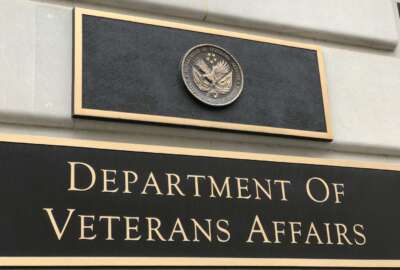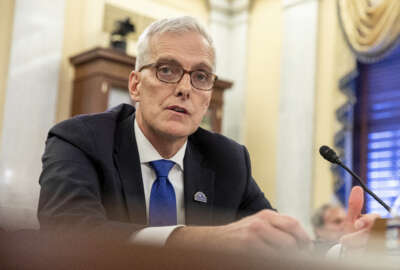

The Department of Veterans Affairs is already meeting one of its goals to grow its health care workforce by the end of the fiscal year, and remains on track to meet...
The Department of Veterans Affairs is already meeting one of its goals to grow its health care workforce by the end of the fiscal year and remains on track to meet its other hiring targets.
The Veterans Health Administration has met its fiscal 2023 goal of increasing total employees in the health care system by 3%.
Undersecretary for Health Shereef Elnahal told reporters Tuesday that VHA achieved its FY 2023 workforce goal through a combination of increased hiring and a higher retention rate, compared to recent years.
VHA made over 27,000 external hires so far this fiscal year, and its total workforce has grown by more than 11,000 employees — a 3.1% growth in its workforce. Elnahal said that’s VHA’s highest growth rate in more than 20 years.
“We are knocking last year out of the water, in terms of hiring and retention performance,” he said.
VHA is staffing up to handle a surge of veterans entering the VA health care system under the PACT Act. The legislation, signed into law last August, expands VA health care and benefits for veterans exposed to toxic burn pits during their military service.
VHA so far this fiscal year has seen a 2.9% loss rate in its workforce, well below its average loss rate of 4.6%. Last year, VHA saw a loss rate of 5.7%
“The market is calming down in the form of contract labor and some of the really high-salary opportunities for a lot of our staff,” Elnahal said.
VHA has also sought to address burnout among its health care workforce through its REBOOT Task Force.
VHA remains more than halfway to its goal of hiring 52,000 external hires by the end of fiscal 2023.
“We can’t hire enough people right now, now knowing what the care demand will be, once the several hundred-thousand PACT Act claims that have come in really begin to be processed,” Elnahal said.
VHA in February reduced its time-to-hire for the first time in fiscal 2023.
Elnahal said VHA is making “sustainable progress on reducing the time it takes to bring people on board,” but is looking to further reduce the time-to-hire.
“We’re about level on time-to-fill, despite the record numbers of hires that we’re seeing, because we’re basically pushing a lot more people through an existing system. And even as we improve that existing system and that process, the number of folks that need to go through it continues to increase,” Elnahal said. “So we’re not yet seeing a sustained reduction. I do hope we make progress systemwide on that, sooner rather than later.”
VHA is also directing its health care facilities across the country to reduce wait times for veterans.
“We are seeing some improvements in wait times despite increased demand,” Elnahal said.
Elnahal said about 59% of facilities are currently meeting VHA’s goal of a 3% improvement in direct care wait times for primary care.
“We think it’s an appropriate target, and we don’t expect all of our facilities to meet that goal initially. Sometimes, we have to do a lot of upfront work over the course of many months before we start to see the results on access,” he said.
About 40% of facilities are meeting that wait-time reduction goal in terms of in-person mental health care. However, those metrics don’t include many of VHA’s telehealth appointments.
However, just over 20% of facilities are meeting the wait-time reduction goal for specialty care. Elnahal attributed some of those lower metrics to the VA’s challenges recruiting high-cost specialists.
Members of the Senate VA Committee are looking to address that challenge. Committee Chairman Jon Tester (D-Mont.) and Sen. John Boozman (R-Ark.) introduced the VA CAREERS Act in January, and would set higher base pay caps for VA physicians, podiatrists, optometrists and dentists.
The legislation would lift the $400,000 current pay cap for specialist physicians, dentists and podiatrists.
Elnahal said having a “market pay-based system for all of our clinicians,” as envisioned by the VA CAREERS Act, would give veterans better access to specialty care, and would help the VA cut costs.
Elnahal said the VA is currently contracting out a lot of specialist care, and is already “paying well above $400,000” for these clinicians in those cases.
“Our veterans are, in many cases, aging. They have multiple comorbidities, we need more and more of these specialists within the VA,” he said.
Elnahal also said he supports the VA’s recent decision to put on hold all future deployments of its new Oracle-Cerner Electronic Health Record on hold until it addresses problems at sites already using the system.
“This is not yet a product that is configured in a manner that allows us to operate the way that we think we need to operate on behalf of veterans,” Elnahal said.
The VA’s “program reset” marks the agency’s third prolonged pause in the troubled Oracle-Cerner rollout.
“I have to believe that when our collective attention, focus [and] resources are dedicated to improving the system where it exists, this thing has to improve. This is one of our last chances, I think, to be able to do that, and I think the reset is that opportunity,” Elnahal said.
Elnahal said the reset and the pause on all new EHR go-lives would give VA the opportunity to focus more resources and attention on the five sites already using the Oracle-Cerner system.
Lawmakers have been frustrated by delays in the VA EHR modernization efforts and patient safety issues.
“I want to see improvements manifest in a way that users tell me that this is now a better system. It doesn’t have to be perfect, no EHR is. But the fact that we are in this situation at the five sites is meaningful, and it has to change sooner rather than later,” Elnahal said.
Copyright © 2024 Federal News Network. All rights reserved. This website is not intended for users located within the European Economic Area.
Jory Heckman is a reporter at Federal News Network covering U.S. Postal Service, IRS, big data and technology issues.
Follow @jheckmanWFED


